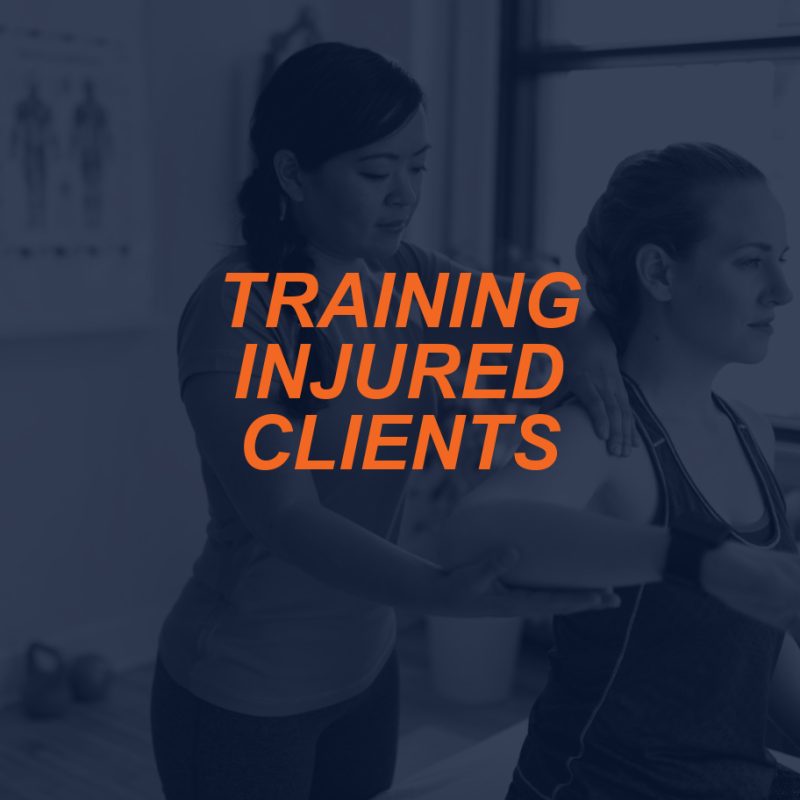
The types of injured clients who may come to us will vary:
New clients
- People may come to train with us for the first time and explain that they are just returning to exercise after previously injuring themselves (which may be in the recent or even distant past)
Existing clients
- Clients we already work with may injure themselves outside of their time with us (i.e., an athlete you train gets injured during a game)
- Clients we already work with may get injured as a result of training with us
The most important aspect of recovering from injury is ensuring the client sought medical attention to receive an accurate diagnosis and to gain an understanding of the prognosis. With new clients, it is important to understand this history and for existing clients, we can check in with them along the way. Once the injured client has been cleared by their physician or therapist to return to exercise, training can begin.
A few questions the trainer can ask the client would be:
- What is the injury? And, if relevant, Do you know what caused it?
- When did the injury occur and what timeline were you given for recovery?
- What recommendations did your physician/physical therapist give you?
- Is the injury still causing pain or dysfunction?
These questions can help us begin to understand the injury, how their recovery is going, and what their restrictions may be.
Commit to Learning
Most trainers have a general idea of some of the more common injuries, but learning about specific injuries in depth can help us to support our clients when returning to exercise after injury, such as back injuries, rib injuries and knee injuries. Don’t be afraid to admit what you don’t know, and commit to learning more about the injury your client may be dealing with.
Know that while reading research and overviews on injuries will be helpful, each injury is unique. Take time to listen to your clients, to understand their experience and the knowledge they’ve acquired about the injury.
Join the Injured Clients’ Care Team
One way to support your existing injured clients in returning to exercise is to be a part of their wellness team during their recovery. Depending on your client, their wellness team and whether you have the capacity to do so, you may be able to communicate with the physician or physical therapist to collaborate with them and help to reinforce their recommendations. This will also allow you to ask any questions you may have, to learn more about the client’s unique injury.
Aside from this helping you to do your job better, it also exemplifies your commitment to your client and their recovery. This sort of support may even help to optimize recovery; research has shown that relatedness is a psychosocial need that, when met, can yield positive results as an athlete returns to sport after injury.
Rehabilitative Exercise
When first returning to exercise after injury, training will be an extension of rehabilitation. Exercise can help with the healing process as it increases blood flow and circulation vital for the healing process, but it is essential to ease back in to avoid any setbacks.
Depending on the injury, you may be able to program exercises that will avoid the injury entirely (i.e., an injured wrist may still allow the client to continue some core work, lower body exercises, and cardio, like walking). Other injuries may require some corrective exercise involving strength work and mobilization around the injured site, among other programming attention to other muscles. This, again, will depend on recommendations from the physician or therapist and your skill level in performing assessments and interpreting your observations accurately.
Using the rehab exercises as a baseline will help the trainer to slowly and safely progress movement. Aside from assessing form and programming the workouts, trainers must coach the clients on the importance of restraint and patience in building back strength and mobility.
Beyond the Physical
Recovery is not purely physical; injuries can contribute to psychological stress and social isolation.
In addition to relatedness, a psychosocial need mentioned above, research has shown that autonomy and competence are important needs to be met when recovering from injury.
Autonomy-supportive coaching will look like listening to the client, acknowledging and valuing their perspective and their feelings. It can build back their confidence to provide choices in certain aspects of their training. The data on competence suggests that trainers should use language that orients clients toward success, rather than away from failure. For example, we should focus on what clients should do, rather than what they should not. Additionally, it’s important to avoid comparison to pre-injury performance and abilities.
We will likely need to build trust with new clients and, potentially, regain the trust of our existing clients if they were injured while working with us. Commitment to learning, becoming a part of their wellness team and programming smart, rehabilitative exercises will all help us to create a supportive environment for our clients to succeed when returning to exercise after injury and to prevent the recurrence of injury.
References
https://www.sciencedirect.com/science/article/abs/pii/S1469029206000902?via%3Dihub
https://www.frontiersin.org/articles/10.3389/fspor.2021.569590/full
https://www.pinnaclehealthchiro.com/blog/why-rehabilitative-exercise-after-an-injury-is-so-important#:~:text=Increasing%20blood%20flow%20and%20circulation,interfere%20with%20mobility%20and%20recovery.
https://issuu.com/sportsinaction/docs/march_2021_-_digital/s/11863123#:~:text=Being%20autonomy%20supportive%20as%20a,pressures%2C%20demands%2C%20or%20consequences.
https://www.ncbi.nlm.nih.gov/pmc/articles/PMC7246734/






